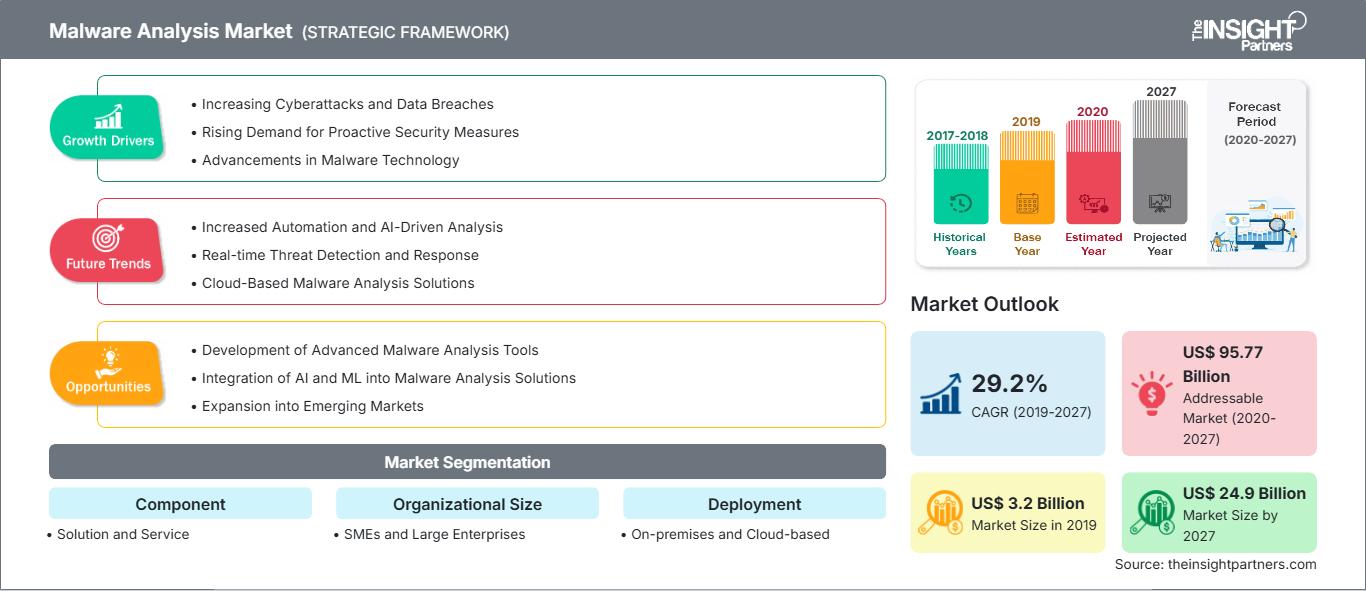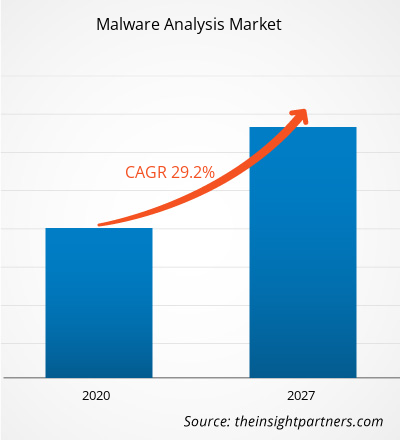[Rapport de recherche] Le marché de l'analyse des logiciels malveillants devrait passer de 3 204,4 millions de dollars américains en 2019 à 24 898,3 millions de dollars américains d'ici 2027 ; sa croissance devrait atteindre un TCAC de 29,2 % entre 2019 et 2027.
La multiplication des initiatives gouvernementales contribue à la croissance du marché. Les gouvernements de plusieurs pays à travers le monde prennent des initiatives pour soutenir l'adoption d'outils d'analyse des logiciels malveillants par les entreprises. Par exemple, en 2017, le gouvernement indien a lancé Cyber Swachhta Kendra, un centre de nettoyage et d'analyse des logiciels malveillants de botnets. Ce centre vise à détecter les infections de botnets dans le pays et à prévenir de nouvelles infections en les notifiant, en permettant le nettoyage et en sécurisant les systèmes des utilisateurs finaux. Par ailleurs, en mars 2019, une nouvelle loi européenne sur la cybersécurité a été approuvée par le Parlement européen. Ce nouveau règlement crée un cadre européen de certification de la cybersécurité. Ce cadre vise à accroître la transparence des garanties de cybersécurité des produits, services et processus TIC, et ainsi à renforcer la confiance et à aider les utilisateurs finaux à faire des choix éclairés. Un autre objectif essentiel de ce cadre est d'éviter la multiplication des certifications nationales contradictoires ou redondantes et ainsi de réduire les coûts. Conformément au règlement, la CE est autorisée à adopter les systèmes européens de certification de cybersécurité, définis par l'ENISA, concernant des groupes spécifiques de produits, services et processus TIC. Ces systèmes pourraient couvrir, par exemple, les produits, services et processus TIC utilisés dans les avions, les voitures, les dispositifs médicaux, les centrales électriques, ainsi que les appareils grand public connectés à Internet. En 2018, l'Autorité monétaire de Singapour (MAS) a lancé une subvention de 22 millions de dollars américains pour les capacités de cybersécurité afin d'aider les institutions financières du pays à renforcer leur cyber-résilience et à perfectionner les talents locaux grâce à des programmes de formation liés à la cybersécurité, tels que l'analyse des logiciels malveillants, les opérations de sécurité, l'informatique légale, la surveillance et la chasse aux cybermenaces. De telles initiatives gouvernementales devraient stimuler la croissance du marché de l’analyse des logiciels malveillants.
Personnalisez ce rapport en fonction de vos besoins
Vous bénéficierez d’une personnalisation sur n’importe quel rapport - gratuitement - y compris des parties de ce rapport, ou une analyse au niveau du pays, un pack de données Excel, ainsi que de profiter d’offres exceptionnelles et de réductions pour les start-ups et les universités
Analyse du marché des logiciels malveillants: Perspectives stratégiques

- Obtenez les principales tendances clés du marché de ce rapport.Cet échantillon GRATUIT comprendra une analyse de données, allant des tendances du marché aux estimations et prévisions.
Analyse du marché–
Vous bénéficierez d’une personnalisation sur n’importe quel rapport - gratuitement - y compris des parties de ce rapport, ou une analyse au niveau du pays, un pack de données Excel, ainsi que de profiter d’offres exceptionnelles et de réductions pour les start-ups et les universités
Analyse du marché des logiciels malveillants: Perspectives stratégiques

- Obtenez les principales tendances clés du marché de ce rapport.Cet échantillon GRATUIT comprendra une analyse de données, allant des tendances du marché aux estimations et prévisions.
Marché de l'analyse des logiciels malveillants : adoption croissante des solutions numériques par divers secteurs d'activité
La mise en œuvre de solutions numériques s'accélère dans divers secteurs, notamment l'industrie manufacturière, la santé, l'automobile, les entreprises de services financiers et d'investissement (BFSI), les médias et le divertissement, ainsi que le commerce de détail. Ces secteurs bénéficient de plus en plus de la transformation numérique. L'analyse leur permet de mieux comprendre et servir les clients. De plus, l'accès à des informations en temps réel permet une prise de décision efficace. L'automatisation des opérations commerciales leur permet d'accroître leur productivité. Par exemple, les constructeurs automobiles ont révolutionné leur processus de fabrication grâce à l'utilisation de robots ; et les compagnies aériennes sont devenues expertes en matière de tarification grâce à des informations en temps réel sur l'offre et la demande. De plus, les entreprises de vente au détail dotées de solides capacités numériques ont conçu des environnements omnicanaux fluides. De plus, le secteur de la santé s'est modernisé grâce aux dossiers médicaux électroniques (DME), aux outils numériques qui suivent les signes vitaux des patients, ainsi qu'aux consultations virtuelles entre patients et médecins. Cependant, avec l'adoption croissante des technologies numériques telles que l'IoT, le Big Data et l'IA, dans les entreprises comme dans la société en général, la connectivité croissante de tous les éléments a créé des défis en termes de conformité, de sécurité et de protection des données. Ainsi, la lutte contre les nouvelles tendances en matière de logiciels malveillants favorise l'adoption d'outils d'analyse des logiciels malveillants.
Informations basées sur les composants
Le marché de l'analyse des logiciels malveillants est segmenté en solutions et services par composants. Le segment des solutions détenait la plus grande part de marché en 2018.
Informations basées sur la taille de l'organisation
Le marché de l'analyse des logiciels malveillants est segmenté en grandes entreprises et en petites et moyennes entreprises par taille. Le segment des grandes entreprises détenait la plus grande part de marché en 2018.
Les acteurs du marché de l'analyse des logiciels malveillants se concentrent principalement sur le développement de produits avancés et performants.
- En 2019, Google Cloud et Palo Alto Networks ont annoncé de nouvelles solutions pour assurer la sécurité de leurs clients. Les deux sociétés collaboreront pour proposer de nouvelles offres sur le marché et exécuter plusieurs services Palo Alto Networks sur Google Cloud.
- En 2019, Kaspersky a annoncé son premier centre de transparence en Asie-Pacifique en partenariat avec CyberSecurity Malaysia pour servir d'installation de confiance aux partenaires de l'entreprise et aux parties prenantes gouvernementales pour venir vérifier le code source des solutions Kaspersky.
Marché de l'analyse des logiciels malveillants
Les tendances régionales et les facteurs influençant le marché de l'analyse des logiciels malveillants tout au long de la période de prévision ont été analysés en détail par les analystes de The Insight Partners. Cette section aborde également les segments et la répartition géographique du marché de l'analyse des logiciels malveillants en Amérique du Nord, en Europe, en Asie-Pacifique, au Moyen-Orient et en Afrique, ainsi qu'en Amérique du Sud et en Amérique centrale.
Portée du rapport sur l'analyse du marché des logiciels malveillants| Attribut de rapport | Détails |
|---|---|
| Taille du marché en 2019 | US$ 3.2 Billion |
| Taille du marché par 2027 | US$ 24.9 Billion |
| TCAC mondial (2019 - 2027) | 29.2% |
| Données historiques | 2017-2018 |
| Période de prévision | 2020-2027 |
| Segments couverts |
By Composant
|
| Régions et pays couverts | Amérique du Nord
|
| Leaders du marché et profils d'entreprises clés |
|
Densité des acteurs du marché de l'analyse des logiciels malveillants : comprendre son impact sur la dynamique des entreprises
Le marché de l'analyse des logiciels malveillants connaît une croissance rapide, portée par une demande croissante des utilisateurs finaux, due à des facteurs tels que l'évolution des préférences des consommateurs, les avancées technologiques et une meilleure connaissance des avantages du produit. Face à cette demande croissante, les entreprises élargissent leur offre, innovent pour répondre aux besoins des consommateurs et capitalisent sur les nouvelles tendances, ce qui alimente la croissance du marché.
- Obtenez le Analyse du marché des logiciels malveillants Aperçu des principaux acteurs clés
- Solution
- Service
Marché de l'analyse des logiciels malveillants - par taille d'organisation
- PME
- Grande entreprise
Marché de l'analyse des logiciels malveillants - par déploiement
- Sur site
- Basé sur le cloud
Marché de l'analyse des logiciels malveillants - par secteur d'activité de l'utilisateur final
- BFSI
- Gouvernement
- Santé
- Informatique et télécommunications
- Fabrication
- Autres ... secteur d'activité de l'utilisateur final par géographie
- Amérique du Nord
- États-Unis
- Canada
- Mexique
- Europe
- France
- Allemagne
- Italie
- Russie
- Royaume-Uni
- Reste de l'Europe
- Asie-Pacifique (APAC)
- Japon
- Chine
- Australie
- Inde
- Corée du Sud
- Reste de l'APAC
- Moyen-Orient et Afrique (MEA)
- Arabie Saoudite
- EAU
- Afrique du Sud
- Reste de la MEA
- Amérique du Sud (SAM)
- Brésil
- Argentine
- Reste de SAM
Marché de l'analyse des logiciels malveillants – Profils d'entreprise
- AO Kaspersky Lab
- AT&T
- Broadcom
- Cisco
- CrowdStrike
- FireEye
- Fortinet
- Palo Alto Networks
- Qualys
- Trend Micro
- Analyse historique (2 ans), année de base, prévision (7 ans) avec TCAC
- Analyse PEST et SWOT
- Taille du marché Valeur / Volume - Mondial, Régional, Pays
- Industrie et paysage concurrentiel
- Ensemble de données Excel
Rapports récents
Témoignages
Raison d'acheter
- Prise de décision éclairée
- Compréhension de la dynamique du marché
- Analyse concurrentielle
- Connaissances clients
- Prévisions de marché
- Atténuation des risques
- Planification stratégique
- Justification des investissements
- Identification des marchés émergents
- Amélioration des stratégies marketing
- Amélioration de l'efficacité opérationnelle
- Alignement sur les tendances réglementaires
- Amérique du Nord




















 Obtenez un échantillon gratuit pour - Analyse du marché des logiciels malveillants
Obtenez un échantillon gratuit pour - Analyse du marché des logiciels malveillants